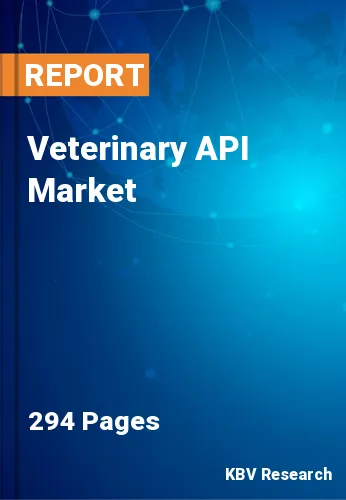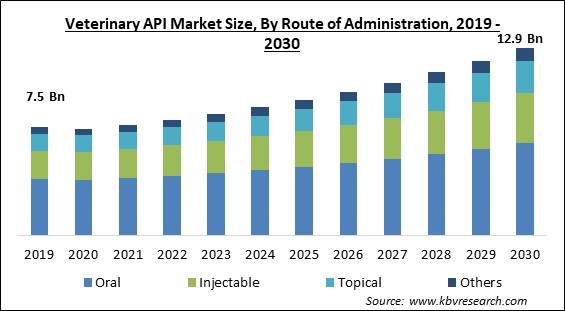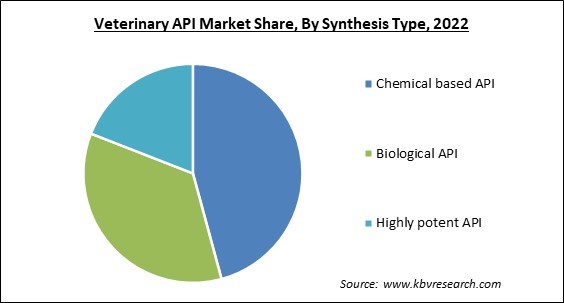
The Global Veterinary API Market size is expected to reach $12.9 billion by 2030, rising at a market growth of 6.4% CAGR during the forecast period.
The market expansion can be attributed to factors such as the increasing demand for meat and meat products, the growing concern for animal health and welfare, and technological advancements in animal husbandry. Therefore, the Hormones segment generated $566.6 million revenue in the market in 2022. Animal hormones are substances produced by an animal's body that regulate numerous vital physiological processes, including growth, development, reproduction, and metabolism. Increased understanding among farm and pet owners regarding the accessibility of veterinarians and animal healthcare products is the primary reason for the significant increase in animal medicalization rates in developing nations. The increased number of veterinary visits increased the demand for diagnostic tests and treatment options, increasing the demand for anti-infectives, anti-microbial, antiparasitics, vaccines, etc. Some of the factors impacting the market are increase in understanding of animal health and welfare, increasing prevalence of transboundary and zoonotic diseases, and difficulties in large-molecular-weight API synthesis.

The public's cognizance of animal health and welfare has increased significantly. People are becoming increasingly aware of the significance of providing appropriate care and consideration to animals, including domesticated companions, livestock, and untamed animals. Many organizations are examining the factors that have contributed to the growing awareness of animal health and welfare and the consequences for the veterinary industry and society. Local and international animal welfare organizations have been essential in raising understanding about animal health and welfare. These organizations campaign for the rights and well-being of animals, encourage responsible ownership of pets, and emphasize the significance of humane animal treatment. Due to their potential to cause significant injury to both animals and humans, transboundary and zoonotic diseases are currently a developing concern worldwide. These diseases, like avian influenza, rabies, and African swine fever, threaten public health, animal welfare, and international trade. Consequently, the use of veterinary active pharmaceutical ingredients (APIs) to fight against the spread of these diseases has increased. The availability of adequate and high-quality veterinary active pharmaceutical ingredients is crucial for supporting these initiatives, enabling international cooperation, and mitigating the detrimental effects of such ailments on public health and international trade.
However, the synthesis of large molecule APIs, like proteins and peptides, for veterinary applications presents unique challenges. These difficulties stem from the complexity of large molecules and the particular requirements for their production. Synthesis of large molecule APIs can be time-consuming and expensive. The complexity of the synthesis procedure, the need for specialized apparatus and reagents, and the possibility of low yields or purification difficulties can all contribute to increased expenses. It is necessary to optimize expression systems, such as genetic engineering, improvement of culture conditions, and purification methods, to produce enough large molecule APIs.
Furthermore, the argument that the COVID-19 pandemic decreased the need for animal care is accurate. In most veterinary hospitals, clinics, and other facilities, foot traffic was restricted due to the global outbreak, infection control measures, and state-wide lockdowns. Consequently, most key actors operated at a deficient level or need to be more competent. Lower output, as well as capacity in veterinary pharmaceutical production, might result in product unavailability and disrupted supply chains, which had a negative impact on market growth.
Based on API type, the market is categorized into parasiticides, vaccines, antimicrobials, anti-inflammatories, hormones, and others. In 2022, the parasiticides segment of the market recorded the highest revenue share. Increasing R&D spending on veterinary API production and rising parasitic infections in companion and livestock animals are expected to contribute to market expansion over the forecast period. Due to accelerated urbanization and increasing disposable income, pet ownership is rising in these nations. In these countries, more pet owners are willing to spend more on their pets' care, which supports the segment's demand.
Based on route of administration, the market is segmented into oral, injectable, topical, and other segments. Injectables are anticipated to have a significant market revenue share in 2022. The segment's expansion can be attributed to the prevalence of chronic diseases in animals, which has increased the demand for vaccines. In addition, increasing livestock populations and animal husbandry and commercializing animal products are projected to increase demand for vaccines, thereby driving segment expansion. Vaccinations against rabies, equine influenza virus, and foot-and-mouth disease are the most frequently administered animal vaccines, which inhibit the transmission of infectious pathogens by reproducing naturally acquired immunity.
Based on synthesis type, the market is segmented by type of synthesis into chemical-based API, biological API, and highly potent API. In 2022, the biological API segment captured a significant market revenue share. This results from the widespread commercial acceptance of these products and increased research on biological veterinary medications. A number of pharmaceutical companies and contract API manufacturers provide biological APIs for the development of specific therapeutic medications for chronic veterinary diseases such as cancer.

On the basis of animal type, the market is segmented by animal type into companion animals and livestock animals. In 2022, the companion animals segment of the market attained a substantial revenue share. This is due to the rise in pet ownership, the increasing prevalence/incidence of various diseases, the rising cost of pet healthcare, and the large number of companies offering pet pharmaceutical products. Pet owners around the globe are increasingly willing to pay for veterinary medications, such as antibiotics, anti-infectives, nonsteroidal anti-inflammatory drugs (NSAIDs), and parasiticides, among others. Such factors greatly contribute to market growth.
| Report Attribute | Details |
|---|---|
| Market size value in 2022 | USD 8 Billion |
| Market size forecast in 2030 | USD 12.9 Billion |
| Base Year | 2022 |
| Historical Period | 2019 to 2021 |
| Forecast Period | 2023 to 2030 |
| Revenue Growth Rate | CAGR of 6.4% from 2023 to 2030 |
| Number of Pages | 294 |
| Number of Table | 470 |
| Report coverage | Market Trends, Revenue Estimation and Forecast, Segmentation Analysis, Regional and Country Breakdown, Companies Strategic Developments, Company Profiling |
| Segments covered | Route of Administration, API Type, Synthesis Type, Animal Type, Region |
| Country scope | US, Canada, Mexico, Germany, UK, France, Russia, Spain, Italy, China, Japan, India, South Korea, Singapore, Malaysia, Brazil, Argentina, UAE, Saudi Arabia, South Africa, Nigeria |
| Growth Drivers |
|
| Restraints |
|
Regionally, the market is analyzed in North America, Europe, Asia Pacific, and LAMEA. North America dominated the market in 2022 by generating the highest revenue share. Significant localized prominence of major animal healthcare companies, beneficial reimbursement programs, an elevated incidence of zoonotic diseases, and expanding R&D in veterinary healthcare all contribute to this substantial share. Zoonoses (zoonotic diseases) are a significant problem in North America because they pose an additional hazard to public health, given that animals are frequently the source of infectious diseases. The high prevalence of zoonotic diseases is a further factor leading to segment growth.
The market research report covers the analysis of key stake holders of the market. Key companies profiled in the report include Boehringer Ingelheim International GmbH, Zoetis, Inc., Elanco Animal Health, Inc., Merck & Co., Inc., Virbac, Vetoquinol SA (Soparfin SCA), Sequent Scientific Limited, Phibro Animal Health Corporation, Febbrica Italina Sintetici S.P.A. (Nine Trees Group S.p.A) and Excel Industries Limited.
Free Valuable Insights: Global Veterinary API Market size to reach USD 12.9 Billion by 2030
By Route of Administration
By API Type
By Synthesis Type
By Animal Type
By Geography
This Market size is expected to reach $12.9 billion by 2030.
Increasing prevalence of transboundary and zoonotic diseases are driving the Market in coming years, however, Difficulties in large-molecular-weight API synthesis restraints the growth of the Market.
Boehringer Ingelheim International GmbH, Zoetis, Inc., Elanco Animal Health, Inc., Merck & Co., Inc., Virbac, Vetoquinol SA (Soparfin SCA), Sequent Scientific Limited, Phibro Animal Health Corporation, Febbrica Italina Sintetici S.P.A. (Nine Trees Group S.p.A) and Excel Industries Limited.
The Antimicrobials segment has shown the high growth rate of 6.1% during (2023 - 2030).
The Chemical based API segment is leading the Market by Synthesis Type in 2022, thereby achieving a market value of $5.6 billion by 2030.
The North America region dominated the Market by Region in 2022, and would continue to be a dominant market till 2030; thereby, achieving a market value of $4.6 billion by 2030.
Our team of dedicated experts can provide you with attractive expansion opportunities for your business.
